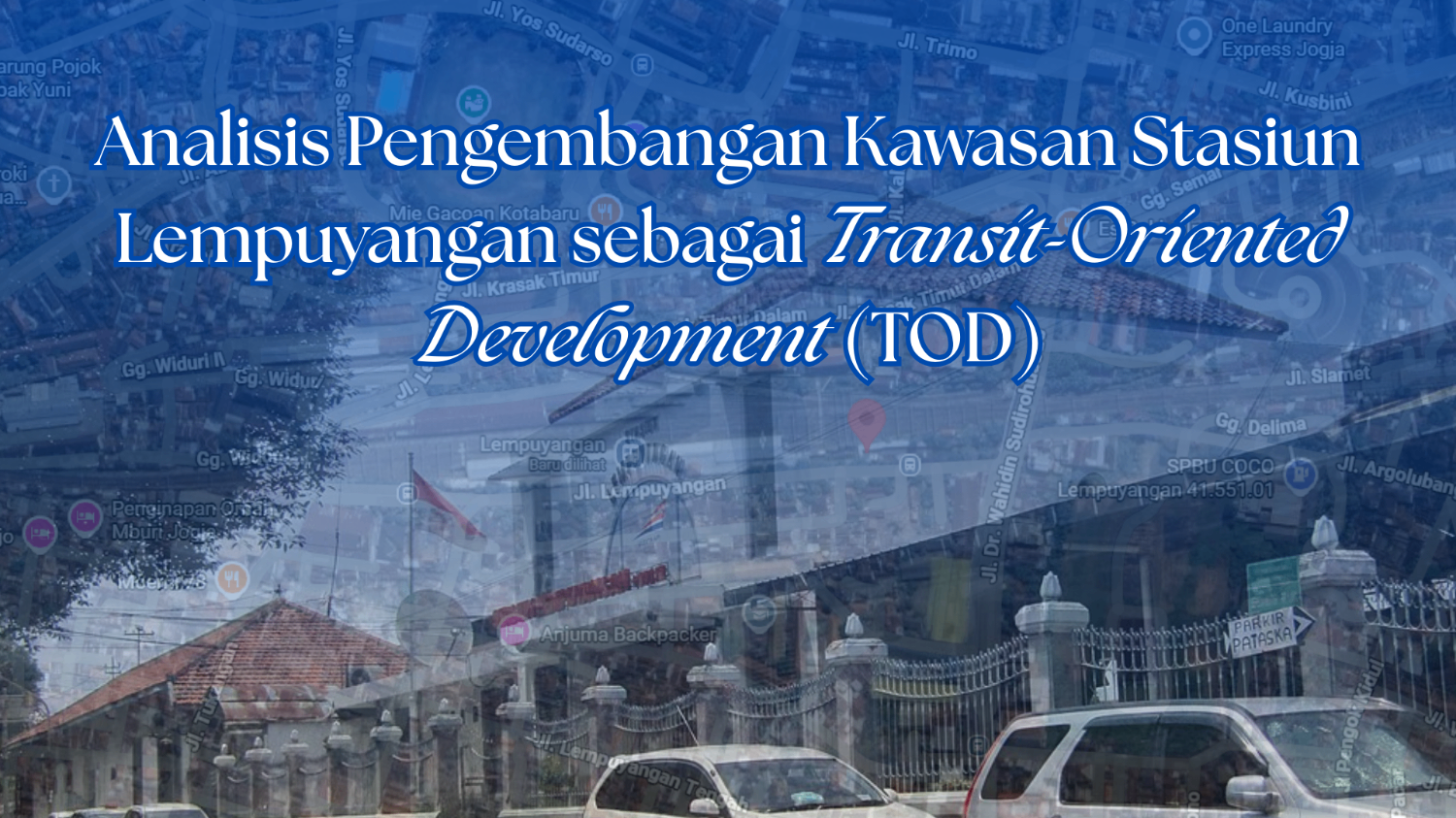A study case article by Ariyani Nurulita Ikhlas, Dika Puspita Sari, and M.Putra Rizky
If y
ITeam ProjectIntroduction
Transit Oriented Development (TOD) concept, which emphasizes major transit facilities such as trains and buses, is being actively pursued in Indonesia. One of the area set to implement this concept is Jakarta Bandung High-Speed High-Speed Rail Corridor at Halim Perdanakusuma, Makasar, East Jakarta. The Halim Perdanakusuma TOD aims to enhance accessibility and improve connectivity among KCJB, Jabodetabek LighLight Rail Transit ), Transjakarta Bus Bus Rapid TransitT), non-BRT buses, and shuttles. The development plan for this area is oriented towards an integrated public transportation system that minimizes distances, thereby contributing to a compact city model and reducing the public’s dependence on private vehicles. As part of the Metropolitan City, efforts to develop a transportation network in Halim area have been underway for several years. The integration of TOD concept will enhance the pre-existing transit facilities.
The development of the transportation network in the vicinity of KCJB Halim area has implications for land cover changes, including green open space or RTH. Decreasing the extent of green open spaces area can lead to adverse environmental impacts, such as an average Land Surface TLand Surface Temperaturee. Therefore, mapping the green open spaces around Halim area becomes crucial. The result of green open space mapping can be used to assess the environmental impacts of the transportation network development, particularly regarding the Urban HUrban Heat Islandeffect, and serve as an initial consideration in providing recommendations related to TOD plan in KCJB Halim area, East Jakarta.
Discussion
The development of KCJB is located near public facilities that serve as areas for community activities. Visualization of public facilities in the vicinity of KCJB Halim area is present in Figure 1A, consisting of schools, hotels, and industrial areas, as shown in Table 1. Meanwhile, Transjakarta BRT, Jabodebek LRT, and KCJB routes are presented sequentially in Figure 1B, 1C, and 1D.


A four-year spatial mapping study of green open spaces around the KCJB Halim area has brought to light significant transformations. Figure 2 visualizes the changes in green open spaces over four timelines. In 2016, when the Jakarta-Cikampek toll road was already operational, the area still featured several green spaces area, serving as vital green sanctuaries for the natural environment and the local population. However, the landscape began to change in 2018, coinciding with the commencement of the Light Rail Transit (LRT) project. In the realm of transportation endeavors, green spaces is frequently sacrificed to accommodate LRT tracks and stations, inevitably resulting in the displacement of established green zones. Consequently, several green spaces area have transformed into open spaces or newly constructed roadways.

The year 2019 marked a significant milestone in the transformation of this area as the KCJB development project commenced. This development led to a significant decrease in green spaces and fundamentally changed the area's character. Several residential areas were converted into open land, reducing the pre-existing green spaces or vegetation. In 2022, the most recent updates reveal that development in the KCJB vicinity has intensified. Additional constructions, such as office buildings and public facilities have replaced area once designated as green spaces, further reducing the remaining green areas in the vicinity.

The reduction in green spaces reflects a significant shift in land use around the KCJB Halim over the past few years (Figure 3). The outcomes of this mapping provide valuable insight into the impact of development on green spaces area, which has substantial implications for both environmental and the quality of life of the local community. The reduction of green spaces contributes to global climate change, including through the UrbaUrban Heat Island (UHI) effect. An Urban Heat Island (UHI) refers to a localized area within a city or urban area that experiences higer temperatures compared to its surrounding rural area due to human activities, modification in land use, and the built environment. Moreover, the Urban Heat Island (UHI) effect can become even more pronounced with the decrease in green spaces area, as these green areas play a crucial role in micro-urban temperatures. The reduction of green spaces can lead to increased surface temperatures then can disrupt the population's comfort and health.
Land SurfacLand Surface Temperature rovides temporal and spatial information related to surface temperature, which can be further utilized to analyze climate change, vegetation monitoring, hydrological cycles, evapotranspiration, and other environmental studies. The distribution of land surface temperature in TOD planning area over four development timelines is visualized in FiguresFigures 4 The 5.rface temperature distribdistribution varies ar, but high surface temperatures consistently occur in the upper right quadrant and partially in the lower right quadrant. The existing conditions in 2022 include the Bus Rapid Transit (Transjakarta) route, built-up areas like residential zones, KCJB transportation network, LRT transportation network, and Jakarta-Cikampek toll road.



The minimum and maximum surface temperatures show an annual increase during each year of development (Figure 6). Using a linear forecast approach that considers the surface temperature variables from previous years, the results indicate that both minimum and maximum surface temperatures will continue to rise annually. Meanwhile, to visualize the temperature distribution across the entire area, surface temperatures have been classified into five categories with a minimum value of 21°C and a maximum value of 36°C, as shown in Figure 7.

In 2022, the minimum surface temperature in the study area reached 28.04°C, covering an area of 19.06 hectares. The minimum surface temperature that year is even higher when compared to the maximum surface temperature in 2016, which had a value of 27.38°C. The increase in minimum temperature in 2022 is attributed to the reduction of green open spaces due to land clearing for the construction of the Jakarta-Bandung high-speed rail network, which began in 2019. Furthermore, this increase is supported by numerous industrial areas and the use of private vehicles, including the Jakarta-Cikampek toll road.
Changes in the distribution area of surface temperatures at the initial (2016) and final stage (2022) of the development are visualized in Figure 8. Negative values indicate a decrease, while positive values indicate an increase in the distribution area of temperatures. In 2022, we can see a reduction in the area for the temperature range of 24-27°C by 152.89 hectares, or in other words, there was no area within this temperature range in this year. In 2022 was dominated by surface temperatures >30��C, covering an area of 163 hectares, or approximately 89.53% of the total study area.

The increase in Land Surface Temperature (LST) has Land Surface Temperature an increase in Urban Heat Island (UHI), which can Urban Heat Islandeased air quality, increased energy consumption for temperature control, reduced water quality, elevated health issues, and a decrease in the quality of life index.
Reducing the green open spaces area can diminish ecological functions that impact the imbalance of urban ecosystems. Disruption of urban ecosystem functions is indicated by increased air pollution, deteriorating soil conditions, and an elevated risk of urban flooding. One of the most felt impacts by local communities is the increase in surface temperatures. The increase in air temperatures can decrease comfort conditions within an area, making it less favorable for urban residents to carry out their activities. Green open spaces play a crucial role in improving the urban environment, so their existence must be preserved or expanded.
The analysis of land cover and temperature revealed that before the commencement of TOD development, there had been a decrease in the area of green open spaces that increasing land surface temperature. The proposed TOD development in the study area has the potential to decrease the extent of green open spaces, which impacts increasing the minimum surface temperatures. We are putting forth several recommendations to mitigate these effects and promote sustainable urban development.
Vegetation enrichment is carried out to increase the number of existing plant species either in existing green open spaces or other open areas, thus expanding the green spaces in Halim Perdanakusuma. The selection of plant species for enrichment is determined by criteria consist of their ability to absorb pollutants, serve as ground cover plants (providing shade), and enhance the aesthetic appeal of urban spaces. The list of selected plant species can be found in Table 2, and the planting patterns are visualized in Figures 9 and 10.



The relocation of plant species tends to solve the loss of green open spaces due to TOD infrastructure development. Relocation is carried out by preserving plant species affected by the construction and moving them to other areas. This is done to protect and conserve the existing plant species, thus reducing the Urban Heat Island (UHI) effect and maintaining the balance of the urban ecosystem. Relocated plants can serve as natural heat absorbers, reducing the air temperature in their vicinity and creating cooler areas that help control the urban climate temperatures. Furthermore, plant relocation also impacts the restoration of ecosystems that may have been disrupted due to development.
CONCLUSION
The reduction in green spaces area has occured even before the official implementation of the Transit-Oriented Development concept in Halim Perdanakusuma. This reduction in green cover leads to an increase in land surface temperature, which has potential to decrease air and water quality, as well as increased energy consumption. Therefore, efforts to establish new green space, vegetation enrichment, and species relocation need to be considered in order to minimize the environmental impact of Transit-Oriented Development planning.
----------------------------------- ITeams ----------------------------------
References:
Azizah, N., dan Utami, S. (2021). Keanekaragaman jenis tumbuhan di Taman Cerdas Kota Samarinda. Bioma, 18-24.
Baroroh, Nafisatul., dan Pangi. (2018). Perubahan penutup lahan dan kerapatan vegetasi terhadap urban heat island di Kota Surakarta.��Seminar Nasional Geomatika 2018: Penggunaan dan Pengembagan Produk Informasi Geospasial Mendukung Daya Saing Nasional.
Delarizka, Almira., Sasmito, Bandi., dan Hani'ah. (2016). Analisis fenomena Pulau Bahang��(Urban Heat Island) Di Kota Semarang berdasarkan hubungan antara perubahan tutupan lahan dengan suhu permukaan menggunakan citra multi temporal lansad. Journal Geodesi Undip, 5(4): 165-177.
Ibraeva, Anna., Correia, G.H.A., dan Silvia, C. (2020). Transit-oriented development: A review of research achievements and challenges.��Transportation Research Part A, 132(2020): 110-130.
Irsyam, A. S. D., dan Priyanti. (2016). Suku fabaceae di Kampus Universitas Islam Negeri (UIN) Syarif Hidayatullah, Jakarta, Bagian 1: Tumbuhan polong berperawakan pohon. Jurnal Biologi, 44-56.
Kalfuadi, Y. (2009). Analisis temperature heat index (THI) dalam hubungannya dengan ruang terbuka hijau (Studi Kasus: Kabupaten Bungo-Propinsi Jambi) [Skripsi]. Bogor: Institut Pertanian Bogor.


![[GEODATA] Tutupan Lahan Indonesia](https://mapidstorage.s3.amazonaws.com/general_image/mapidseeit/1684312961161_COVER%20GEODATA_%20Tutupan%20Lahan.png)
![[GEODATA] Status Ekonomi dan Sosial (SES) Indonesia](https://mapidstorage.s3.amazonaws.com/general_image/mapidseeit/1693454652933_20230831-085941.jpg.jpeg)






